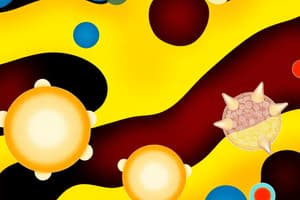Podcast
Questions and Answers
What was a deliberate act by the first settlers of North America?
What was a deliberate act by the first settlers of North America?
- Introducing new crops
- Bringing cats for companionship
- Bringing dogs with them (correct)
- Transporting livestock from Europe
What effect did the Silk Roads have on biological exchange?
What effect did the Silk Roads have on biological exchange?
- It slowed down the exchange of species.
- It connected trade and migration, speeding up exchange. (correct)
- It only benefitted the Roman Empire.
- It isolated different regions.
What essential biological exchange occurred in the Americas before 1492?
What essential biological exchange occurred in the Americas before 1492?
- Import of dogs from Siberia (correct)
- Import of spices from India
- Transfer of cattle to Asia
- Export of coffee to Europe
Which plants and animals did China acquire during periods of heightened biological exchange?
Which plants and animals did China acquire during periods of heightened biological exchange?
What did Columbus initiate in 1492 that impacted biological exchange?
What did Columbus initiate in 1492 that impacted biological exchange?
What significant consequence occurred after Columbus's voyages?
What significant consequence occurred after Columbus's voyages?
What type of exchange was notably absent in the Americas prior to 1492?
What type of exchange was notably absent in the Americas prior to 1492?
What unique biological features characterized Australia and New Zealand?
What unique biological features characterized Australia and New Zealand?
What was the main outcome of the Columbian Exchange for indigenous Americans?
What was the main outcome of the Columbian Exchange for indigenous Americans?
Which diseases were introduced to the Americas through the Columbian Exchange?
Which diseases were introduced to the Americas through the Columbian Exchange?
What factor contributed to the vulnerability of indigenous populations to new diseases?
What factor contributed to the vulnerability of indigenous populations to new diseases?
Which two diseases were the deadliest among those introduced to the Americas from Africa?
Which two diseases were the deadliest among those introduced to the Americas from Africa?
What was a common consequence of the epidemics on indigenous communities?
What was a common consequence of the epidemics on indigenous communities?
Why did many indigenous people starve during the epidemics?
Why did many indigenous people starve during the epidemics?
What emotional impact did the epidemics have on indigenous populations?
What emotional impact did the epidemics have on indigenous populations?
How did European colonization affect the health of indigenous populations?
How did European colonization affect the health of indigenous populations?
What percentage did the populations in the Americas fall between 1492 and 1650?
What percentage did the populations in the Americas fall between 1492 and 1650?
Which disease is suggested as a possible candidate for having transferred from the Americas to Eurasia and Africa?
Which disease is suggested as a possible candidate for having transferred from the Americas to Eurasia and Africa?
Why did the first Americans arrive relatively free from infections?
Why did the first Americans arrive relatively free from infections?
What was never domesticated by the indigenous people of the Americas, contributing to lower infection rates?
What was never domesticated by the indigenous people of the Americas, contributing to lower infection rates?
What was the perception of European observers regarding the devastation caused by disease in the Americas?
What was the perception of European observers regarding the devastation caused by disease in the Americas?
What was transported from the Americas to other continents during the Columbian Exchange but did not become significant elsewhere?
What was transported from the Americas to other continents during the Columbian Exchange but did not become significant elsewhere?
Which animals were primarily domesticated by the indigenous people of the Americas?
Which animals were primarily domesticated by the indigenous people of the Americas?
How did John Winthrop view the depopulation of native people due to smallpox?
How did John Winthrop view the depopulation of native people due to smallpox?
What significant development started in the fifteenth and sixteenth centuries?
What significant development started in the fifteenth and sixteenth centuries?
Which of these regions stood apart from Africa and Eurasia before 1492?
Which of these regions stood apart from Africa and Eurasia before 1492?
What role did oceanic voyaging play in the development of a global web?
What role did oceanic voyaging play in the development of a global web?
Which group first fully deciphered oceanic winds and currents?
Which group first fully deciphered oceanic winds and currents?
What was one of the most significant consequences of spinning the first truly Global web?
What was one of the most significant consequences of spinning the first truly Global web?
What did Zheng He's voyages between 1405 and 1433 demonstrate?
What did Zheng He's voyages between 1405 and 1433 demonstrate?
What aspect of the Global web formation involved economically significant plants and animals?
What aspect of the Global web formation involved economically significant plants and animals?
How did the oceanic voyaging contribute to the world after the 1490s?
How did the oceanic voyaging contribute to the world after the 1490s?
What was one of the new opportunities that Europeans found in their interactions with other societies?
What was one of the new opportunities that Europeans found in their interactions with other societies?
What was a significant penalty of isolation for societies with few connections to the Old World?
What was a significant penalty of isolation for societies with few connections to the Old World?
How did the arrival of European ships affect isolated societies?
How did the arrival of European ships affect isolated societies?
Which major religions spread to new areas as a result of the formation of the Global web?
Which major religions spread to new areas as a result of the formation of the Global web?
What did the spread of languages like Arabic, Spanish, and English lead to?
What did the spread of languages like Arabic, Spanish, and English lead to?
In what ways did the transformation of the Global web affect cultural diversity?
In what ways did the transformation of the Global web affect cultural diversity?
What technological advantages did most isolated societies lack compared to Europeans?
What technological advantages did most isolated societies lack compared to Europeans?
Which of the following describes the global context around the year 1400?
Which of the following describes the global context around the year 1400?
Flashcards are hidden until you start studying
Study Notes
Biological Exchange
- Biological exchange, the transfer of plants, animals, and pathogens, has been a significant factor in human history.
- Early examples include the intentional introduction of animals by settlers and unintentional spread of diseases.
The Pace of Biological Exchange
- The pace of biological exchange accelerated during periods of increased trade and travel.
- The Silk Roads during the Roman and Han Empires facilitated the exchange of species between China and the Mediterranean region.
- Trade in the Arabian Sea in the ninth century CE spurred the exchange of crops between India, East Africa, and the Mediterranean.
Americas Biologically Apart
- The Americas remained largely isolated from the Old World web of exchange before 1492.
- The only significant exchanges were the introduction of the dog from Siberia and the export of the sweet potato to Polynesia.
- Australia and New Zealand also remained isolated, hosting unique flora and fauna.
After the Voyages of Columbus
- The voyages of Columbus linked the Americas to the Old World web, creating a biologically interactive network.
- This exchange, known as the Columbian Exchange, transformed both the Americas and the Old World.
Columbus's Contribution
- Columbus's expeditions initiated the Columbian Exchange, with the deliberate transfer of species between Europe and the Americas.
- New World inhabitants received hundreds of plants and animals from Eurasia and Africa, as well as devastating diseases.
The Impact of Deadly Diseases, 1492-1700
- European travelers introduced numerous diseases to the Americas, including smallpox, measles, mumps, whooping cough, and influenza.
- These diseases were endemic in the Old World, but native Americans had no prior exposure and lacked immunity.
- European colonization further weakened native populations, making them more susceptible to disease.
- Yellow fever and falciparum malaria, spread by mosquitos, also arrived from Africa, contributing to the devastating impact.
The Impact of the Deadly Diseases on a Mexican Village
- A Mexican village in the 16th century experienced a catastrophic epidemic.
- The villagers were helpless and unable to care for themselves, leading to death from both the disease and starvation.
Consequences of the Epidemics
- In many communities, the social fabric collapsed due to the intensity of the epidemics and the resulting loss of hope.
- Population decline in the Americas was dramatic, dropping 70-95% between 1492 and 1650.
The Americas' Infectious Disease's Lesser Impact on Africa and Eurasia
- The Americas had limited infectious diseases that significantly impacted Africa and Eurasia.
- The first migrants to the Americas had spent time in cold climates that may have killed off some pathogens.
- The lack of domesticated herd animals in the Americas reduced the likelihood of zoonotic diseases.
- The Columbian Exchange was largely unidirectional, with the Americas suffering the most significant consequences.
The Columbian Exchange and Domesticated Animals
- The Columbian Exchange was also asymmetrical with respect to domesticated animals.
- While turkeys and guinea pigs were introduced to other continents, they did not become widespread.
- Alpacas and llamas never prospered outside their native Andes.
The Beginnings of a Global Web
- The oceanic voyages of the 15th and 16th centuries connected continents into a single global web.
- The Americas, previously largely isolated, now became integrated into this global web.
The Oceanic Voyaging Tightened Linkages
- Oceanic voyaging strengthened connections within the Old World web, facilitating trade and cultural exchange.
The Spinning of the Global Web
- The formation of the global web had significant consequences, including biological globalization and the rise of European influence.
- The spread of Atlantic Europeans, with their advanced navigation and military capabilities, significantly shaped world history.
The Penalties of Isolation
- Societies isolated from the Old World web suffered from lack of immunity to diseases like measles, influenza, and smallpox.
- Isolated people also lacked advanced technology and weaponry, making them vulnerable to conquest.
The Transformation of Global Web
- The global web resulted in a decrease in cultural diversity, with the spread of major religions like Christianity and Islam.
- The increased use of languages like Arabic, Spanish, and English also led to a reduction in linguistic diversity.
Conclusion
- The world in 1400 consisted of multiple interconnected webs, with the Americas largely isolated.
- The voyages of Columbus and other explorers connected the world into a single global web, with profound consequences for biological exchanges, cultural dynamics, and global power.
Studying That Suits You
Use AI to generate personalized quizzes and flashcards to suit your learning preferences.




